
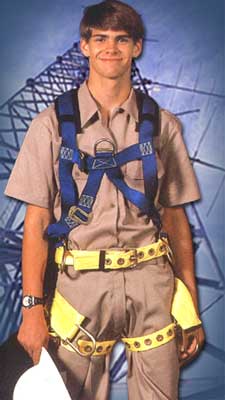 Service Information Service Information
Safety Equipment
Of all tower industry safety equipment, no single piece gets more attention than the full body harness. It does not come in a herringbone pattern yet, but manufacturers are always exploring ways to provide a lighter, more comfortable and functional harness. From memory quick fit connecting buckles and comfortable seat slings to easily accessible lanyard rings, product development specialists are frequently consulting with field personnel to make their harnesses more climber-friendly with the latest innovations.
 In their literature, two manufacturers even discuss how good looking their harness is. Well, we are not quite sure if making a bold fashion statement on the job site will help you get through the day more quickly, but comfort, mobility and safety are primary considerations when you are in your full body harness up to 12 or more hours per day. In their literature, two manufacturers even discuss how good looking their harness is. Well, we are not quite sure if making a bold fashion statement on the job site will help you get through the day more quickly, but comfort, mobility and safety are primary considerations when you are in your full body harness up to 12 or more hours per day.
One harness doesn’t fit all, in both size and the intended use. What might be more functional and comfortable for a tower painter may not serve the needs of an erector who is laden with more spud wrenches, equipment and connecting hardware than one individual should have the right to enjoy. Harnesses come with a back D-ring for connection to fall a protection system and a front D-ring for use with a climbing ladder safety system. wrenches, equipment and connecting hardware than one individual should have the right to enjoy. Harnesses come with a back D-ring for connection to fall a protection system and a front D-ring for use with a climbing ladder safety system.
Safety climbs and other protection devices have been reviewed as a possible contributor to a casualty, but properly maintained and secured, full body harnesses have not come into question. All harnesses are required to meet or exceed numerous industry standards including ANSI Z359, the most stringent compliance standard.
We recommend that you contact our listed safety equipment manufacturers and their distributors to obtain additional 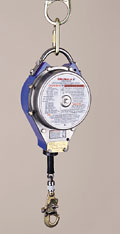 information about their products and services. information about their products and services.
 Safety equipment pricing is relatively competitive, but some manufacturers offer a wider selection of products. In example, full body harnesses are available from $87.00 to $299.00, because erectors might want to spend additional money for a product that can make their workday considerably more comfortable. However, there are few measurable benefits of a 6’ shock-absorbing lanyard that meets all design codes and regulations. PPE equipment per employee costs the employer in excess of $600.00. Pricing does not include taxes or freight. Safety equipment pricing is relatively competitive, but some manufacturers offer a wider selection of products. In example, full body harnesses are available from $87.00 to $299.00, because erectors might want to spend additional money for a product that can make their workday considerably more comfortable. However, there are few measurable benefits of a 6’ shock-absorbing lanyard that meets all design codes and regulations. PPE equipment per employee costs the employer in excess of $600.00. Pricing does not include taxes or freight.
| Description |
Price
|
| Full Body Harness, Fall Arrest, Positioning |
$225.00 |
| 6' Work Positioning Lanyard w/Snap Hooks |
$49.00 |
| 6' Shock Absorbing Lanyard |
$68.00 |
| Rope Grab |
$128.00 |
| 2" Self closing/Locking Steel Carabiner |
$54.00 |
| 18" D-Ring Extension |
$27.00 |
| 50' Self Retracting Lifeline |
$935.00 |
| 100' Self Retracting Lifeline |
$1,525.00 |
Inspect before you climb
Safety equipment manufacturers stress that any equipment that has been exposed to a fall must be taken out of service and not used 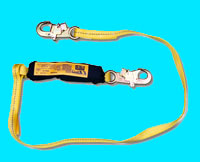 again for fall protection. OSHA requires that all fall arrest equipment be inspected prior to its use. Aging, mechanical wear and ultraviolet ray degradation can weaken safety equipment over time. Inspection includes looking for frays or broken strands in lanyards, belts, and lifelines, and for oxidation or distortion of any metal connection devices. Used safety equipment is available on line, but it is recommended by safety professionals that you avoid the temptation to acquire an inexpensive offering since the purchaser can not be assured that the equipment has not been exposed to overstressing and should have been taken out of service. again for fall protection. OSHA requires that all fall arrest equipment be inspected prior to its use. Aging, mechanical wear and ultraviolet ray degradation can weaken safety equipment over time. Inspection includes looking for frays or broken strands in lanyards, belts, and lifelines, and for oxidation or distortion of any metal connection devices. Used safety equipment is available on line, but it is recommended by safety professionals that you avoid the temptation to acquire an inexpensive offering since the purchaser can not be assured that the equipment has not been exposed to overstressing and should have been taken out of service.
Suit and badge up for safety
When a tower technician is working in areas not in compliance with maximum permissible RF exposure limits, then personal protective equipment must be used. RF protective clothing should be worn to reduce the electromagnetic energy exposure.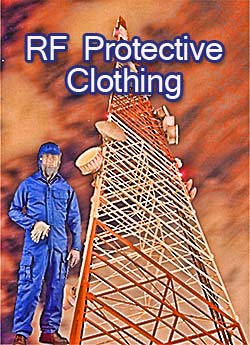
RF attenuation suits have coveralls and gloves to protect the body and a hood for head protection. Polyester yarn is wound coaxially around stainless steel fibers to produce the surface of the RF attenuation suit. Tests have demonstrated that suits can effectively reduce EME absorption within the body at virtually any frequency over the telecommunications spectrum. When working at lower frequency fields, the technician may be able to wear the suit without the hood.
Don’t worry if your socks don’t match your suit, just make sure you wear them. Without RF socks you will not have a path to ground and the currents in the suit will pass through your ankles. Although warm feet on a cold Minnesota climb might sound tempting, the high Specific Absorption rates are dangerous.
Another safety tool for limiting RF exposure, the personal RF monitor, oftentimes referred to as a badge, sends an alarm when the RF threshold (usually 50% of the occupational, controlled MPE) is exceeded. When nearing an antenna that needs maintenance, the tower technician can place the badge near the antenna to identify if the transmitter has been deactivated.
Personal monitors average $1,600 each. A popular selection operates over the frequency range of 3 MHz to 40 GHz and contains both electric and magnetic (E and H) field sensors. Monitors are generally shaped to match the higher level of two-tier standards, i.e., the “Controlled”, “Occupational”, or “RF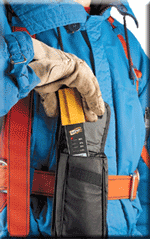 Worker” limits. Some monitors can log hundreds of sets of data that can be used to analyze personnel exposures. Worker” limits. Some monitors can log hundreds of sets of data that can be used to analyze personnel exposures.
A monitor is available for use in strong ELF fields, such as where wireless antennas are mounted on towers that carry high voltage 50/60 Hz utility power. Most monitors are not designed for this environment and false alarms are known to occur.
If the tower technician wears the monitor on a belt and not at chest level, it may give a false sense of security. When the technician's head and shoulders enter high RF fields, the belt-worn monitor might not provide an alarm. Monitors should not be worn underneath RF suits.
Before a technician begins ascending, they must ensure that the appropriate transmitters have been deactivated and locked out. This precaution prevents someone from accidentally turning on the transmitters while a technician is performing maintenance. With so many antennas sharing one tower, it becomes more difficult to confirm that all of the transmitters are deactivated. that exceed RFR exposure limits. It may not be possible to have the co-located antennas that are not being serviced powered down.
In Wireless Estimator's Discussion Forum there is a section that focuses upon Safety Issues. You are invited to start a new thread or reply to an existing one; however, it is advised that you review all relative safety regulations and consult a safety professional prior to relying upon the accuracy of any forum member's information.
|